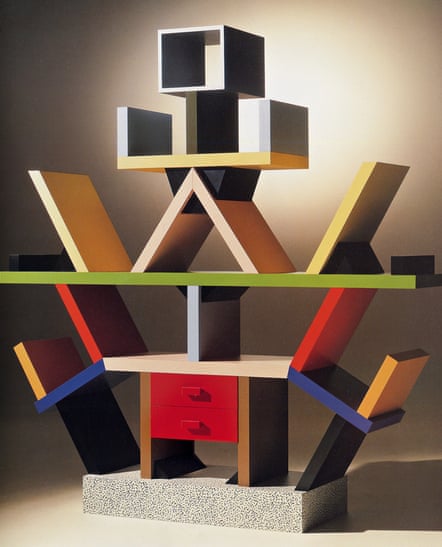The receptionist gave me a fax and an odd look. It said, in handwritten capitals: "DEAR ROWAN MOORE… THANK YOU FOR EVER… ETTORE", above a drawing of a dishevelled bed with condoms and discarded underwear on the floor beside. It was from Ettore Sottsass, then approaching 80 years old, who liked a review I had written for the magazine where I was then working, of a book of his photographs. The review had noted his camera's fondness for post-coital beds, hence the drawing.
Sottsass (1917-2007) is now remembered most as the godfather of Memphis, the design collective whose much-imitated works released a flood of wonky angled, brightly coloured furniture in laminated plastic, striped, polka-dotted and leopard-skinned, on the 1980s. Memphis was launched in a Milan gallery in September 1981, in a near riot of 2,000 people (amazing that furniture can arouse such passions). Its original pieces now sell in auction houses for prodigious sums.
As usual in such cases, the imitators betray the inventors, and actual Sottsass designs from this period have a spirit, a presence and a touch that make their calculated outrages against taste all the more powerful. The copies are plain outrageous. But, as a handsome new Phaidon monograph amply shows, Sottsass was very much more than Memphis. At a hundred pounds sterling and seven pounds avoirdupois, it is both weighty and expensive, but within its pistachio covers and striped endpapers, on pages of varying stock and multiple colours, a life of astonishing richness is revealed. It shows a man whose young, dashing moustache becomes progressively more mournful and perplexed, but whose appetite for life never diminished.

Born in the Dolomites to Italian-Austrian parentage, Ettore Sottsass was a designer of furniture, buildings, ceramics, graphics, textiles, lights, jewellery and electronic products. He was a (not very good) painter, sculptor, writer and publisher of magazines. He was a voracious taker of photographs and maker of drawings. In the second world war he was an unwilling soldier on the wrong side, stationed in Montenegro. Early in his career, broke, he would "work through the night" to create "stands for a vermouth advertisement, to earn a few lire while consumed by deep boredom".
In the 1960s he had a fruitful collaboration with Olivetti, in which he created typewriters for the electronics corporation, and Elea, a computer as elegant as such things could be in the days when they were the size of rooms. At the same time he would make earthenware pots inspired by his interest in tantric art and a passion for Indian culture. He hung out with Beat poets in California and took Allen Ginsberg on a speaking tour of Italy, where the writer was at one point charged with indecency.

Sottsass was a social genius. With his first wife, Fernanda Pivano, and with his later lovers, he created multiple circles of extraordinary people, documented by his photographs: Ginsberg, Bob Dylan, Picasso, Max Ernst, Alice Toklas, Chet Baker, Jack Kerouac, Helmut Newton, Robert Mapplethorpe, Alberto Moravia and Ernest Hemingway. And, as he put it: "I like girls and ladies very much."
Common to all of this was a belief that his work should be in unison with the world. For him, it was all interconnected, with his photographs helping to link the personal and the visual, or the human and the material. When he designed a typewriter or an adding machine, his primary concern was not the technology of the machinery inside it, but the physiology and feelings of the person who would use it. When he designed furniture, he was thinking less of the perfection of the object than of the room in which it might sit and of the life that might be going on in that room. "To be an architect," he said, "you have to become very gentle, very calm and extremely sensitive about life."

He was opposed to standardisation and the modernist tendency to design "like a well-educated schoolboy". He was interested in uncertainty, inconclusion, sensuality, melancholy and pleasure. "Everything must remain possible," he said and: "It must be possible to design instability." He liked "bastard situations", where many factors combined. He saw design not only as the fulfilling of a function, but of proposing ways of doing so: a chair could suggest "a new way to sit", and with it a fragment of a new world.
What this meant in practice, in the physical detail of his multiple works, is harder to define. Colour, pattern and curves are the most obvious but not invariable features, as are a bringing together of unlikely companions of form and material. Also the influence of tribal and popular art – his pieces often carry totemic, ritualistic or erotic suggestions. In his buildings (and although he was better at other things, he always liked to think of himself as an architect before all else) he would favour forms reminiscent of children's drawings or building blocks.

His greatness existed less in individual creations than in the space between everything he did. Some designers, such as Arne Jacobsen or Charles and Ray Eames, are closely identified with celebrated chairs or other pieces. For Sottsass the equivalent might be his Carlton room divider for Memphis, or his Valentine typewriter for Olivetti, but these alone don't explain his fame – it was the work, ideas and life together that mattered.
If he failed at anything it was that he might have overrated the power of objects to change the world. He was part of 1960s counterculture, and suspicious of such things as marketing and consumerism, but as a product designer he was in a business that is mostly about selling things. It was all too easy for his inventions to be sucked into the 1980s orgy of acquisition and display and, again now, to become collectible signs of status. But, if so, his life was a magnificent way to fail.

Comments (…)
Sign in or create your Guardian account to join the discussion